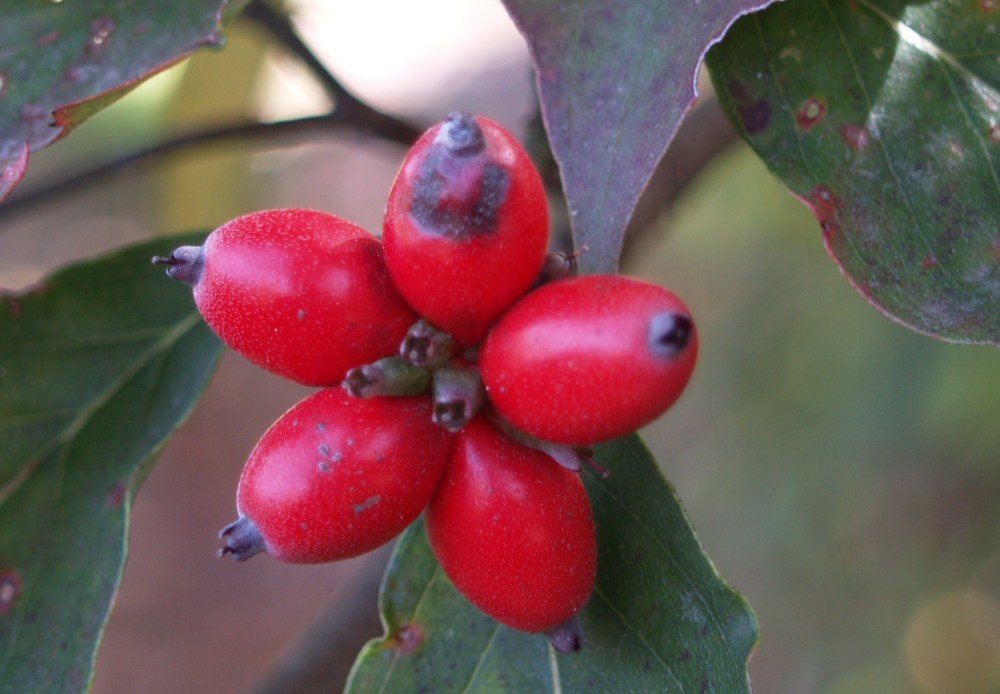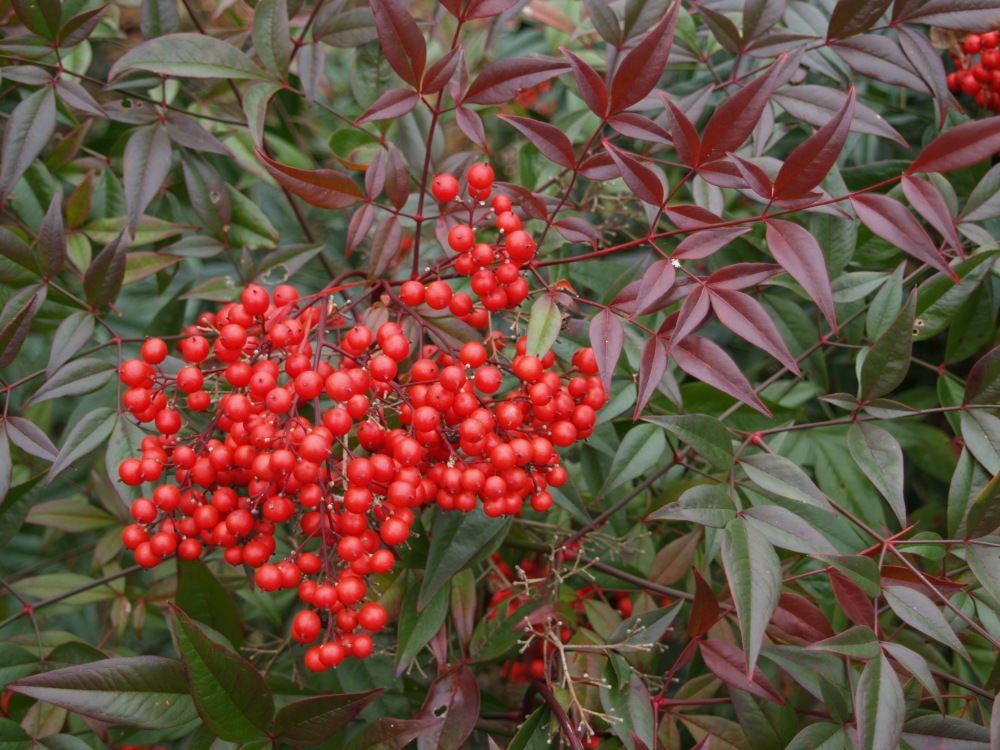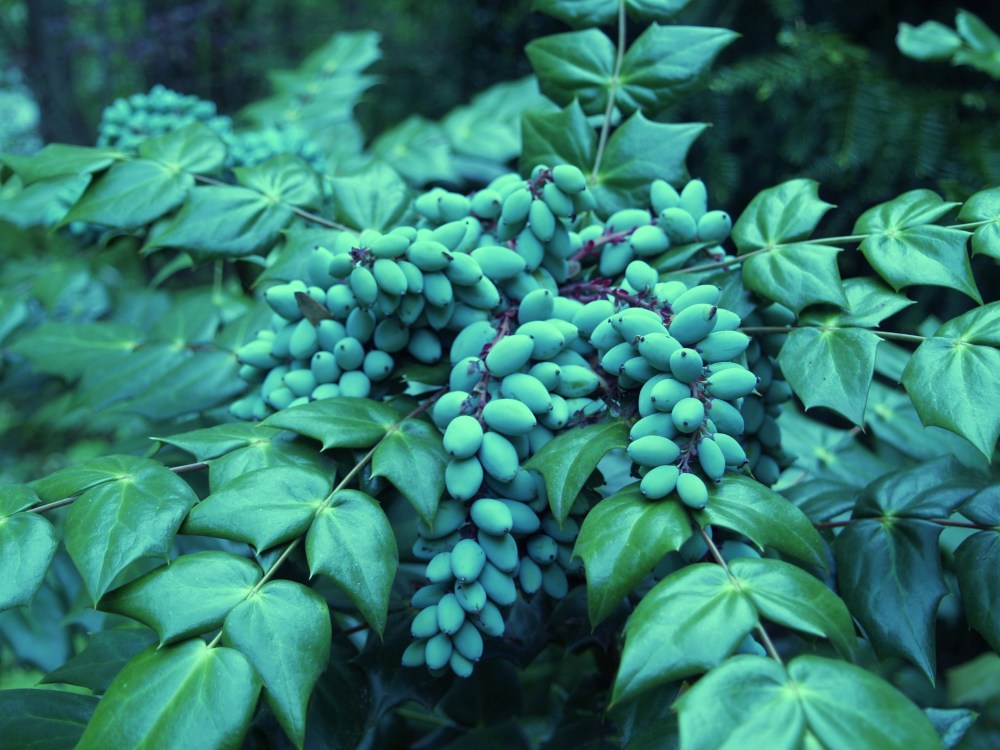Gardeners, I suppose, are an optimistic lot, sometimes ignoring the obvious for years, or even a lifetime. There is ample evidence that I am a slow learner, with lessons too often requiring a decade or two, if they are ever to be learned. And, so it is with winter berries, or at least many berries that the gardener presumes must be vital to the survival of neighborhood birds, but often are consumed only in desperation nearing winter’s end. Or, not at all.
There seems no question that berries of the native dogwood (Cornus florida, above) are appreciated, since by mid December the clusters of red berries are long gone. Berries of the native, and large strawberry-like fruits of the Chinese dogwood (Cornus kousa, below) rarely last more than a few weeks past ripening, though it is not unusual to find a few ripened fruits on the ground beneath the trees. While dogwood berries are often touted for their winter appeal, none linger in this garden much past the date when the foliage drops.


More abundant berries of nandinas (Nandina domestica, above) and hollies (Ilex koehneana, below) persist through the winter and often into early spring before dropping, mostly ignored by birds until there is little other nourishment available. Even then, most berries remain uneaten. Certainly, the gardener expects he has done a good deed planting to supply wildlife with winter sustenance, but disappointingly, birds tastes are more discriminating so that many berries are more for ornament than as a food source for wildlife.

Nandina’s berries are mildly toxic so that they are not recommended for a wildlife garden, but I’ve seen that few birds are tempted by the large clusters, even late in the winter. For this reason nandina seedlings are unlikely to stray much further than a seed can fall and roll, so I’ve seen little opportunity for this shrub to spread.
Seedlings of the spring flowering leatherleaf mahonia (Mahonia bealei, above) are occasionally found a distance from the evergreen shrubs. The grape-like fruits that follow its flowers look tasty, and birds strip them quickly once they are ripe. The winter flowering ‘Winter Sun’ (Mahonia x intermedia ‘Winter Sun’) bears fruit only when warmer temperatures in late November and December encourage pollinators to get out and about, so the small fruits are rarely displayed.
Where I live, Cornus capitata (with berries similar to C kousa) is very much favoured by birds, so much so that C capitata seedlings appear everywhere! The hollies are a similar story – holding on until there is little else for the birds to eat. The most favoured berries in my area (for native and introduced bird species) are the Cotoneaster and Ligustrum….
Fruit consumption depends on the weather. In some years the birds will gorge on fruit that they ignore in other years. Sometimes weather drives them away before they can eat it. Usually cedar waxwings and robins strip a wild American holly on my place in late winter, but one year a severe cold snap drove them south and they didn’t return before the insects started hatching out.
Robins typically appear in my garden in late winter when I notice them eating (though sparingly) both holly and nandina berries. By this time I suspect that there’s not much left to eat in the native forest.
Nice berries. In the fall I always regret not adding them to my own garden, and then come spring get distracted by blooms again. Wish the mahonia was hardy enough for me…
As often happens, I began collecting various hollies until there was no more space. Between hollies, cryptomeria varieties, and a scattering of deciduous trees the long northern border of the garden is now a solid mass of foliage. There was never a plan to screen the neighboring properties, but it has turned out that way. Over years the large evergreens are taken for granted, until the berries stand out from the green foliage through the winter.
I have “blue” series hollies and the birds mostly ignore the fruit until late winter. Then I get a flock of cedar waxwings and/or robins and they strip the bushes bare in a few days. I always thought that the freezing and thawing process changed the taste of the berries, making them sweeter (or something).
What I am surprised at is that the birds are ignoring the berries on one of my Viburnum varieties (if I remember right it’s called “cardinal candy” so I thought it would be popular with the birds). It’s covered with berries but the birds haven’t touched it. I may replace it with something more appealing to the birds next year (or more appealing to me, hello hydrangea Pisachio).
Berries that persist long into the winter are likely not to be as flavorful as others, but any berry that is consumed through the winter is valuable. Still, Pistachio is a wonderful hydrangea. My choice always is to find some spot to cram both into the garden.
I’m new to this area and this habitat. This Spring I was delighted to see a lot of bright orange birds eating something in my Flowering Quince. Surely not fruit, but what?